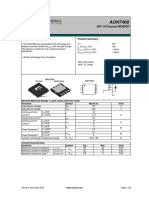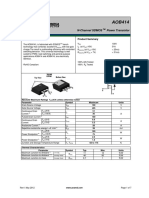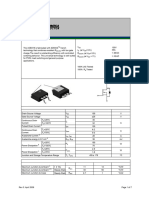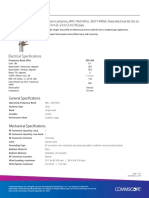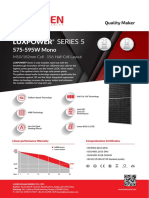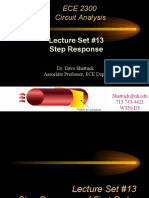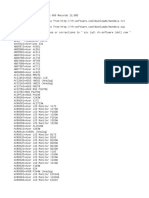AON6504
AON6504
Uploaded by
Mar GaoCopyright:
Available Formats
AON6504
AON6504
Uploaded by
Mar GaoCopyright
Available Formats
Share this document
Did you find this document useful?
Is this content inappropriate?
Copyright:
Available Formats
AON6504
AON6504
Uploaded by
Mar GaoCopyright:
Available Formats
AON6504
30V N-Channel AlphaMOS
General Description Product Summary
• Latest Trench Power AlphaMOS (αMOS LV) technology VDS 30V
• Very Low RDS(on) at 4.5VGS ID (at VGS=10V) 85A
• Low Gate Charge RDS(ON) (at VGS=10V) < 2.1mΩ
• High Current Capability
RDS(ON) (at VGS = 4.5V) < 3.2mΩ
• RoHS and Halogen-Free Compliant
Application 100% UIS Tested
• DC/DC Converters in Computing, Servers, and POL 100% Rg Tested
• Isolated DC/DC Converters in Telecom and Industrial
DFN5X6 D
Top View
Top View Bottom View
1 8
2 7
3 6
4 5
G
PIN1 S
Absolute Maximum Ratings TA=25°C unless otherwise noted
Parameter Symbol Maximum Units
Drain-Source Voltage VDS 30 V
Gate-Source Voltage VGS ±20 V
Continuous Drain TC=25°C 85
ID
Current G TC=100°C 66 A
Pulsed Drain Current C IDM 322
Continuous Drain TA=25°C 51
IDSM A
Current TA=70°C 41
C
Avalanche Current IAS 60 A
Avalanche energy L=0.05mH C EAS 90 mJ
VDS Spike 100ns VSPIKE 36 V
TC=25°C 83
PD W
Power Dissipation B TC=100°C 33
TA=25°C 7.3
PDSM W
Power Dissipation A TA=70°C 4.7
Junction and Storage Temperature Range TJ, TSTG -55 to 150 °C
Thermal Characteristics
Parameter Symbol Typ Max Units
Maximum Junction-to-Ambient A t ≤ 10s 14 17 °C/W
RθJA
Maximum Junction-to-Ambient A D Steady-State 40 55 °C/W
Maximum Junction-to-Case Steady-State RθJC 1.1 1.5 °C/W
Rev1: Nov 2012 www.aosmd.com Page 1 of 6
Electrical Characteristics (TJ=25°C unless otherwise noted)
Symbol Parameter Conditions Min Typ Max Units
STATIC PARAMETERS
BVDSS Drain-Source Breakdown Voltage ID=250µA, VGS=0V 30 V
VDS=30V, VGS=0V 1
IDSS Zero Gate Voltage Drain Current µA
TJ=55°C 5
IGSS Gate-Body leakage current VDS=0V, VGS= ±20V 100 nA
VGS(th) Gate Threshold Voltage VDS=VGS, ID=250µA 1.3 1.7 2.1 V
VGS=10V, ID=20A 1.75 2.1
mΩ
RDS(ON) Static Drain-Source On-Resistance TJ=125°C 2.55 3.15
VGS=4.5V, ID=20A 2.4 3.2 mΩ
gFS Forward Transconductance VDS=5V, ID=20A 120 S
VSD Diode Forward Voltage IS=1A,VGS=0V 0.7 1 V
IS Maximum Body-Diode Continuous CurrentG 85 A
DYNAMIC PARAMETERS
Ciss Input Capacitance 2719 pF
Coss Output Capacitance VGS=0V, VDS=15V, f=1MHz 1204 pF
Crss Reverse Transfer Capacitance 169 pF
Rg Gate resistance VGS=0V, VDS=0V, f=1MHz 0.9 2.0 3 Ω
SWITCHING PARAMETERS
Qg(10V) Total Gate Charge 44 60 nC
Qg(4.5V) Total Gate Charge 21 28 nC
VGS=10V, VDS=15V, ID=20A
Qgs Gate Source Charge 9 nC
Qgd Gate Drain Charge 7 nC
tD(on) Turn-On DelayTime 9.7 ns
tr Turn-On Rise Time VGS=10V, VDS=15V, RL=0.75Ω, 5.2 ns
tD(off) Turn-Off DelayTime RGEN=3Ω 32.5 ns
tf Turn-Off Fall Time 10.3 ns
trr Body Diode Reverse Recovery Time IF=20A, dI/dt=500A/µs 19.6 ns
Qrr µ
Body Diode Reverse Recovery Charge IF=20A, dI/dt=500A/µs 42.7 nC
A. The value of RθJA is measured with the device mounted on 1in2 FR-4 board with 2oz. Copper, in a still air environment with TA =25°C. The
Power dissipation PDSM is based on R θJA and the maximum allowed junction temperature of 150°C. The value in any given application depends
on the user's specific board design.
B. The power dissipation PD is based on TJ(MAX)=150°C, using junction-to-case thermal resistance, and is more useful in setting the upper
dissipation limit for cases where additional heatsinking is used.
C. Single pulse width limited by junction temperature TJ(MAX)=150°C.
D. The RθJA is the sum of the thermal impedance from junction to case RθJC and case to ambient.
E. The static characteristics in Figures 1 to 6 are obtained using <300µs pulses, duty cycle 0.5% max.
F. These curves are based on the junction-to-case thermal impedance which is measured with the device mounted to a large heatsink, assuming a
maximum junction temperature of TJ(MAX)=150°C. The SOA curve provides a single pulse rating.
G. The maximum current rating is package limited.
H. These tests are performed with the device mounted on 1 in2 FR-4 board with 2oz. Copper, in a still air environment with TA=25°C.
THIS PRODUCT HAS BEEN DESIGNED AND QUALIFIED FOR THE CONSUMER MARKET. APPLICATIONS OR USES AS CRITICAL
COMPONENTS IN LIFE SUPPORT DEVICES OR SYSTEMS ARE NOT AUTHORIZED. AOS DOES NOT ASSUME ANY LIABILITY ARISING
OUT OF SUCH APPLICATIONS OR USES OF ITS PRODUCTS. AOS RESERVES THE RIGHT TO IMPROVE PRODUCT DESIGN,
FUNCTIONS AND RELIABILITY WITHOUT NOTICE.
Rev1: Nov 2012 www.aosmd.com Page 2 of 6
TYPICAL ELECTRICAL AND THERMAL CHARACTERISTICS
100 100
4.5V
3.5V VDS=5V
80 80
60 10V 60
ID (A)
ID(A)
40 40
125°C
20 VGS=3V 20
25°C
0 0
0 1 2 3 4 5 0 1 2 3 4 5 6
VDS (Volts) VGS(Volts)
Fig 1: On-Region Characteristics (Note E) Figure 2: Transfer Characteristics (Note E)
4 1.6
Normalized On-Resistance
VGS=10V
3 1.4 ID=20A
Ω)
VGS=4.5V
RDS(ON) (mΩ
2 1.2
1 1 VGS=4.5V
ID=20A
VGS=10V
0 0.8
0 5 10 15 20 25 30 0 25 50 75 100 125 150 175
ID (A)
Temperature (°C)
Figure 3: On-Resistance vs. Drain Current and Gate
Figure 4: On-Resistance vs. Junction Temperature
Voltage (Note E)
(Note E)
5 1.0E+02
ID=20A
1.0E+01
4
1.0E+00
Ω)
3
RDS(ON) (mΩ
125°C 125°C
IS (A)
1.0E-01
2 1.0E-02
25°C
1.0E-03
25°C
1
1.0E-04
0 1.0E-05
2 4 6 8 10 0.0 0.2 0.4 0.6 0.8 1.0 1.2
VGS (Volts) VSD (Volts)
Figure 5: On-Resistance vs. Gate-Source Voltage Figure 6: Body-Diode Characteristics (Note E)
(Note E)
Rev1: Nov 2012 www.aosmd.com Page 3 of 6
TYPICAL ELECTRICAL AND THERMAL CHARACTERISTICS
10 4000
VDS=15V 3500
8 ID=20A Ciss
3000
Capacitance (pF)
2500
VGS (Volts)
6
2000
4 1500
1000 Coss
2
500
Crss
0 0
0 10 20 30 40 50 0 5 10 15 20 25 30
Qg (nC) VDS (Volts)
Figure 7: Gate-Charge Characteristics Figure 8: Capacitance Characteristics
1000.0 500
100.0 RDS(ON) 10µs 10µs 400 TJ(Max)=150°C
TC=25°C
100µs
Power (W)
ID (Amps)
10.0 300 17
1ms
DC 5
1.0 200 2
10
TJ(Max)=150°C
0.1 100
TC=25°C
0.0 0
0.01 0.1 1 10 100
0.0001 0.001 0.01 0.1 1 10
VDS (Volts) 0
Pulse Width (s)
Figure 9: Maximum Forward Biased 18
Figure 10: Single Pulse Power Rating Junction-to-Case
Safe Operating Area (Note F) (Note F)
10
D=Ton/T In descending order
Zθ JC Normalized Transient
TJ,PK=TC+PDM.ZθJC.RθJC D=0.5, 0.3, 0.1, 0.05, 0.02, 0.01, single pulse
Thermal Resistance
RθJC=1.5°C/W 40
1
PD
0.1
7.3 Ton
4.7 T
Single Pulse
0.01
0.00001 0.0001 0.001 0.01 0.1 1 10 100
Pulse Width (s)
Figure 11: Normalized Maximum Transient Thermal Impedance (Note F)
Rev1: Nov 2012 www.aosmd.com Page 4 of 6
TYPICAL ELECTRICAL AND THERMAL CHARACTERISTICS
100 100
90 90
80 80
Power Dissipation (W)
Current rating ID(A)
70 70
60 60
50 50
40 40
30 30
20 20
10 10
0 0
0 25 50 75 100 125 150 0 25 50 75 100 125 150
°C)
TCASE (° °C)
TCASE (°
Figure 12: Power De-rating (Note F) Figure 13: Current De-rating (Note F)
10000
TA=25°C
1000
Power (W)
100
10
1
0.00001 0.001 0.1 10 1000
Pulse Width (s)
Figure 14: Single Pulse Power Rating Junction-to-
Ambient (Note H)
10
D=Ton/T In descending order
TJ,PK=TA+PDM.ZθJA.RθJA
Zθ JA Normalized Transient
D=0.5, 0.3, 0.1, 0.05, 0.02, 0.01, single pulse
Thermal Resistance
1 RθJA=55°C/W
0.1
PD
0.01
Single Pulse
Ton
T
0.001
0.0001 0.001 0.01 0.1 1 10 100 1000
Pulse Width (s)
Figure 15: Normalized Maximum Transient Thermal Impedance (Note H)
Rev1: Nov 2012 www.aosmd.com Page 5 of 6
Gate Charge Test Circuit & Waveform
Vgs
Qg
10V
+
VDC
+ Vds Qgs Qgd
- VDC
DUT -
Vgs
Ig
Charge
Resistive Switching Test Circuit & Waveforms
RL
Vds
Vds
90%
DUT
+ Vdd
Vgs VDC
Rg - 10%
Vgs Vgs td(on) tr td(off) tf
t on toff
Unclamped Inductive Switching (UIS) Test Circuit & Waveforms
L 2
Vds EAR= 1/2 LIAR BVDSS
Id Vds
Vgs + Vdd I AR
Vgs VDC
Rg - Id
DUT
Vgs Vgs
Diode Recovery Test Circuit & Waveforms
Vds + Q rr = - Idt
DUT
Vgs
t rr
Vds - L Isd IF
Isd dI/dt
+ Vdd I RM
Vgs VDC
Vdd
Ig
- Vds
Rev1: Nov 2012 www.aosmd.com Page 6 of 6
You might also like
- Samsung Bn44-00517c Pslf790d04a Parts InfoDocument15 pagesSamsung Bn44-00517c Pslf790d04a Parts InfoDodi Gak DodolNo ratings yet
- General Description Product Summary: 30V N-Channel AlphamosDocument6 pagesGeneral Description Product Summary: 30V N-Channel AlphamosDavid SimonNo ratings yet
- General Description Product Summary: 30V N-Channel AlphamosDocument6 pagesGeneral Description Product Summary: 30V N-Channel AlphamosDenis DenisovNo ratings yet
- AON7523Document6 pagesAON7523jawareh.libyaNo ratings yet
- AON6552Document6 pagesAON6552Dorel ComlosanNo ratings yet
- General Description Product Summary: 30V N-Channel AlphamosDocument6 pagesGeneral Description Product Summary: 30V N-Channel AlphamosDenis DenisovNo ratings yet
- General Description Product Summary: 30V N-Channel AlphamosDocument6 pagesGeneral Description Product Summary: 30V N-Channel AlphamosGarcia F. MarcioNo ratings yet
- AON7548Document6 pagesAON7548Ahmad AmerNo ratings yet
- AON7506Document6 pagesAON7506aldo_suviNo ratings yet
- AON7408Document6 pagesAON7408aldo_suviNo ratings yet
- General Description Product Summary: 30V N-Channel MOSFETDocument6 pagesGeneral Description Product Summary: 30V N-Channel MOSFETSomendra SinghNo ratings yet
- AON6414A: General Description Product SummaryDocument6 pagesAON6414A: General Description Product SummaryJuanes MuñozNo ratings yet
- General Description Product Summary: 30V N-Channel MOSFETDocument5 pagesGeneral Description Product Summary: 30V N-Channel MOSFETaffes electroniqueNo ratings yet
- AON6514Document6 pagesAON6514Cezao DoidãoNo ratings yet
- General Description Product Summary: 30V N-Channel MOSFETDocument6 pagesGeneral Description Product Summary: 30V N-Channel MOSFETSergio PerezNo ratings yet
- AON7430Document6 pagesAON7430deyvid sanchezNo ratings yet
- AON6366E: General Description Product SummaryDocument6 pagesAON6366E: General Description Product SummaryHumberto YumaNo ratings yet
- AON6372Document6 pagesAON6372Akhmad MukhsinNo ratings yet
- Aon6978 PDFDocument10 pagesAon6978 PDFKakang NggaNo ratings yet
- Datasheet 3Document6 pagesDatasheet 3alan segundo garcia chotaNo ratings yet
- AOD4184A: General Description Product SummaryDocument6 pagesAOD4184A: General Description Product SummaryAriel dajaoNo ratings yet
- General Description Product Summary: 30V N-Channel MOSFETDocument6 pagesGeneral Description Product Summary: 30V N-Channel MOSFETRobson ZimmermannNo ratings yet
- General Description Product Summary: 30V P-Channel MOSFETDocument6 pagesGeneral Description Product Summary: 30V P-Channel MOSFETluis alberto perez monteroNo ratings yet
- Aon7410 PDFDocument6 pagesAon7410 PDFGilson3DNo ratings yet
- AON7400ADocument6 pagesAON7400Aa.ansarain101No ratings yet
- AON6280Document6 pagesAON6280Johnsan DrummerNo ratings yet
- Aon 6594Document6 pagesAon 6594Juan Manuel Mendía MontevideoNo ratings yet
- AON7408 30V N-Channel MOSFET: Features General DescriptionDocument4 pagesAON7408 30V N-Channel MOSFET: Features General DescriptionJose Fernandes CanalesNo ratings yet
- General Description Product Summary: 40V N-Channel MOSFETDocument6 pagesGeneral Description Product Summary: 40V N-Channel MOSFETcarlosjamal95No ratings yet
- General Description Product Summary: 30V N-Channel MOSFETDocument6 pagesGeneral Description Product Summary: 30V N-Channel MOSFETTsukamoto TsukushiNo ratings yet
- DatasheetDocument5 pagesDatasheetcody 2No ratings yet
- General Description Product Summary: 30V N-Channel MOSFETDocument5 pagesGeneral Description Product Summary: 30V N-Channel MOSFETTaufik MantofaniNo ratings yet
- General Description Product Summary: 30V N-Channel MOSFETDocument6 pagesGeneral Description Product Summary: 30V N-Channel MOSFETAntonioPeriniNo ratings yet
- AON7430 30V N-Channel MOSFET: General Description FeaturesDocument6 pagesAON7430 30V N-Channel MOSFET: General Description FeaturesE GNo ratings yet
- General Description Product Summary: 30V P-Channel MOSFETDocument5 pagesGeneral Description Product Summary: 30V P-Channel MOSFETteranet tbtNo ratings yet
- AON7410Document6 pagesAON7410Marcio MoraesNo ratings yet
- AOTF404Document6 pagesAOTF404José Mauro Costa MacedoNo ratings yet
- General Description Product Summary: N-Channel SDMOS Power TransistorDocument7 pagesGeneral Description Product Summary: N-Channel SDMOS Power TransistorAndres Fernandez FernandezNo ratings yet
- General Description Product Summary: 80V N-Channel MOSFETDocument6 pagesGeneral Description Product Summary: 80V N-Channel MOSFETRegard'sDexterZacheusNo ratings yet
- General Description Product Summary: 40V Dual N-Channel MOSFETDocument5 pagesGeneral Description Product Summary: 40V Dual N-Channel MOSFETOscar MedinaNo ratings yet
- General Description Product Summary: 30V N-Channel MOSFETDocument6 pagesGeneral Description Product Summary: 30V N-Channel MOSFETShamim DhaliNo ratings yet
- General Description Product Summary: 30V P-Channel MOSFETDocument6 pagesGeneral Description Product Summary: 30V P-Channel MOSFETCarlos Luis ColmenaresNo ratings yet
- aob416Document7 pagesaob416Ahmed SobhyNo ratings yet
- AOD420 N-Channel Enhancement Mode Field Effect Transistor: Features General DescriptionDocument5 pagesAOD420 N-Channel Enhancement Mode Field Effect Transistor: Features General Descriptionwillian GaldinoNo ratings yet
- AOD452A N-Channel SDMOS POWER Transistor: General Description FeaturesDocument7 pagesAOD452A N-Channel SDMOS POWER Transistor: General Description FeaturesAlexsandro TorezinNo ratings yet
- General Description Product Summary: 30V N-Channel MOSFET SdmosDocument7 pagesGeneral Description Product Summary: 30V N-Channel MOSFET SdmosCleiton SilvaNo ratings yet
- AO6402 AlphaOmegaSemiconductorsDocument4 pagesAO6402 AlphaOmegaSemiconductorsMafia BetawiNo ratings yet
- AON6502Document6 pagesAON6502dentronikNo ratings yet
- Srfet: Product Summary General DescriptionDocument5 pagesSrfet: Product Summary General DescriptionShamim DhaliNo ratings yet
- D452 AlphaOmegaSemiconductorsDocument5 pagesD452 AlphaOmegaSemiconductorsamerican cuteNo ratings yet
- Product Summary General Description: 30V N-Channel MOSFETDocument5 pagesProduct Summary General Description: 30V N-Channel MOSFETMafia BetawiNo ratings yet
- AO4409 Mosfet para Ampli Bluetooth ChinoDocument5 pagesAO4409 Mosfet para Ampli Bluetooth ChinoAnival FabregasNo ratings yet
- AONR21357 ReemplazoDocument6 pagesAONR21357 ReemplazoDavid Enrique Rivero CahuichNo ratings yet
- AOD446Document6 pagesAOD446sahabatemanNo ratings yet
- AON6262E AlphaOmegaSemiconductorsDocument6 pagesAON6262E AlphaOmegaSemiconductorsJhon RiosNo ratings yet
- AO4496Document5 pagesAO4496peter notarianniNo ratings yet
- Aod472 PDFDocument6 pagesAod472 PDFJuan Carlos ChavezNo ratings yet
- Product Summary General Description: 30V N-Channel MOSFETDocument6 pagesProduct Summary General Description: 30V N-Channel MOSFETmegha vishwakarmaNo ratings yet
- Design of Electrical Circuits using Engineering Software ToolsFrom EverandDesign of Electrical Circuits using Engineering Software ToolsNo ratings yet
- Digital Portable Power Clamp Harmonics KM 2709Document2 pagesDigital Portable Power Clamp Harmonics KM 2709industrialindia1No ratings yet
- DB586 y PDFDocument2 pagesDB586 y PDFKatiuska CachisNo ratings yet
- Service Manual: ICF-S10MK2Document13 pagesService Manual: ICF-S10MK2LuizNo ratings yet
- Luxpower Series 5: 575-595W MonoDocument2 pagesLuxpower Series 5: 575-595W MonoMS Energia SolarNo ratings yet
- 2310 Lab05Document4 pages2310 Lab05tarottaurus54No ratings yet
- ECS 700 Domain and Control ConfigurationDocument22 pagesECS 700 Domain and Control ConfigurationABVSAINo ratings yet
- Sheet 2 Electronic CircuitsDocument4 pagesSheet 2 Electronic CircuitsWajdi BELLILNo ratings yet
- Datasheet k104Document3 pagesDatasheet k104Luigi PortugalNo ratings yet
- ECE 2300 Circuit Analysis: Lecture Set #13 Step ResponseDocument46 pagesECE 2300 Circuit Analysis: Lecture Set #13 Step Responsevijeta1987No ratings yet
- Debug 1214Document13 pagesDebug 1214AndreeaNo ratings yet
- Highly Efficient Design of Microwave Circuits: Brad Brim Applications Engineer, Ansoft CorpDocument44 pagesHighly Efficient Design of Microwave Circuits: Brad Brim Applications Engineer, Ansoft CorpEnSon ChangNo ratings yet
- TD Dash Cam Instruction ManualDocument7 pagesTD Dash Cam Instruction ManualLakes Media 360No ratings yet
- MondevsDocument233 pagesMondevsŽīã ÝãďãvNo ratings yet
- Half Wave Rectifier CircuitDocument4 pagesHalf Wave Rectifier Circuityopyprasetya0% (2)
- Radar DataDocument240 pagesRadar Dataleandroafm100% (4)
- Aluminum Electrolytic Capacitors: SpecificationsDocument2 pagesAluminum Electrolytic Capacitors: Specificationsnanodocl5099No ratings yet
- M Networking Alpha SignsDocument82 pagesM Networking Alpha SignsduncanmfrNo ratings yet
- Amplificadores Crown Com Tech 810 1610 ServiceDocument459 pagesAmplificadores Crown Com Tech 810 1610 ServiceOlger Quintero TapiaNo ratings yet
- Fisa Tehnica Detector Conventional de Fum Optic Si Temperatura Teletek SensoMAG M40Document2 pagesFisa Tehnica Detector Conventional de Fum Optic Si Temperatura Teletek SensoMAG M40tudor.cosmin.nicolae07No ratings yet
- Especificaciones Tecnicas iDS-7332HQHI-M4 - S - V4.5.0.200 - 20220901Document4 pagesEspecificaciones Tecnicas iDS-7332HQHI-M4 - S - V4.5.0.200 - 20220901ptyfuentesNo ratings yet
- Ansi - Ieee STD 995 - 1987 Efficiency Adjustable Speed Drives PDFDocument32 pagesAnsi - Ieee STD 995 - 1987 Efficiency Adjustable Speed Drives PDFrafaelv123No ratings yet
- QuestionsDocument5 pagesQuestionsnooti0% (1)
- Sihp18N50C, Sihf18N50C: Vishay SiliconixDocument8 pagesSihp18N50C, Sihf18N50C: Vishay SiliconixFrancisReisNo ratings yet
- Dual Band 28 38 GHZ Inverted F Array AntDocument9 pagesDual Band 28 38 GHZ Inverted F Array Antwotangoabush80No ratings yet
- Galaxy 28: Frequency Plan C-Band UplinkDocument3 pagesGalaxy 28: Frequency Plan C-Band UplinkHugo CrespoNo ratings yet
- Astm Es7-83Document11 pagesAstm Es7-83AishwaryaMenonNo ratings yet
- EEE Lab Manual VR23-1Document62 pagesEEE Lab Manual VR23-1bhargavipothireddy8No ratings yet
- Circuit Theory and Networks Fourth Edition Wbut 2014 9789339214265 9339214269 CompressDocument742 pagesCircuit Theory and Networks Fourth Edition Wbut 2014 9789339214265 9339214269 Compresssandipanmaji007100% (2)
- Digital Signal Controller TMS320F2812Document15 pagesDigital Signal Controller TMS320F2812Ramana ManoharNo ratings yet
- A2462 Distortion & Speaker DamageDocument2 pagesA2462 Distortion & Speaker DamageDavid Aldo NavoneNo ratings yet









